What did the rulers of one of the most powerful countries on the continent focus their attention on? Did they take part in feasts, show mercy to their subjects and tame unruly feudal lords? Maybe sometimes. Every second one dealt mainly with ... plotting against his own spouse. Expulsion, imprisonment and even physical liquidation. There were many ways.
Robert the Pious was the son of the King of France, Hugo Kapet. He was crowned at the age of 15. Immediately afterwards, his father started looking for a wife for him. Since he was a king, he should marry a princess, except that they were all busy on the marital market. The French went to Constantinople, but the emperors there were very reluctant to give their daughters to the "barbarians of the West," even if their heads were adorned with crowns.
And suddenly in 988 a free princess appeared. Her name was Rozala, the daughter of the King of Italy, and her husband had just died. Hugh did not mind that she was more than twice his son - she was about 40 years old. She was the daughter of a monarch, and nothing else mattered. 17-year-old Robert had to marry her.
Double bigamy
The marriage did not last long. Robert abandoned his wife and found himself a mistress. She was also older than him, but only 7 years, and recently widowed. Bertha, because that was her name, even met the condition of being a princess (her father ruled Burgundy), but Hugo Capet was not convinced by this.
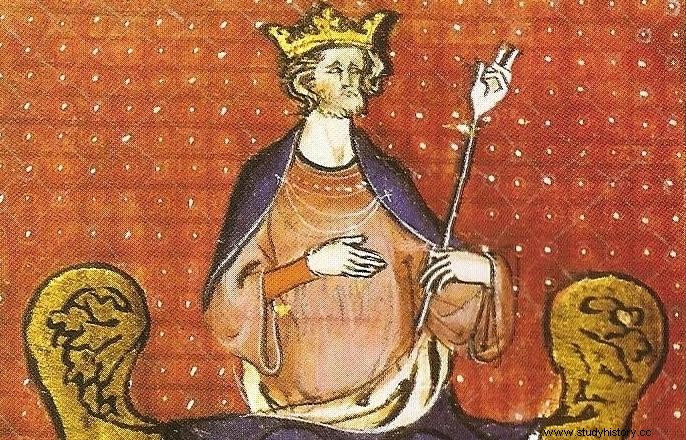
King Hugo I of France, the founder of the Capetian dynasty, had a hard time finding his son a royal consort (source:public domain).
The son waited out his father, who died in 996. Soon after, King Robert called the Pious, assisted by numerous bishops, committed bigamy by marrying Berta. From then on, they were to live happily ever after, but Pope Gregory V intervened and declared their marriage null and void. Bigamy was not a problem, but the kinship between the spouses was. The joint great-grandfather of Robert and Berta, and the Pope, by the way, was the German king Henryk Ptasznik.
The Church forbade incest, and sometimes a very distant relationship between spouses was sufficient to commit this sin. Even the common ancestor in the seventh generation was a problem . In a society where bloodline was almost sacred, marriage was treated as a transaction. We will marry our son to a cousin's daughter who has a nice castle, their child with our uncle's great-grandson who has nice properties in the south ... The broad definition of incest limited such practices.
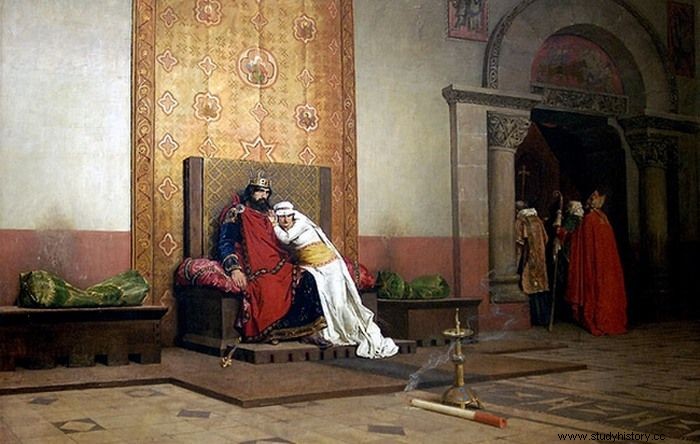
In a painting by Jean-Paul Laurens from 1875, Robert and Berta despair of the papal excommunication. Meanwhile, the spouses - despite the pope's reprimand - were never anathema (source:public domain).
After a few years of a childless incest relationship, Robert broke up with Berta. He needed an heir to the throne that his beloved could not give him. He had a new wife, Constance of Arles, a very unpleasant woman. You can only believe her when she promises something bad used to say Bishop Fulbert of Chartres.
However, when Konstancja had already given Robert two sons, the king decided to get rid of her and return to wife number two . Together with Bertha, they went on a pilgrimage to Rome to appease Pope John XVIII, but they did not do anything. A sad Robert returned to Konstancja with whom he had several more children.
My wife is too fat
In 1092, King Philip I, grandson of Robert the Pious, found after some twenty years of marriage that his wife Berta was too fat and ordered her to be locked up at the castle of Montreuil-sur-Mer. Soon after, he visited Count Anjou, Fulk the Grim, and his wife Bertrada.
Philip I fell in love with an Eugene countess who, as the French historian Régine Pernoud put it, allowed him to graciously kidnap her . He married her, doubly bigamic, and lived to see church curses. Even at the Council of Clermont, where Pope Urban II called on Christians to crusade, they were condemned on the occasion of the King of France.
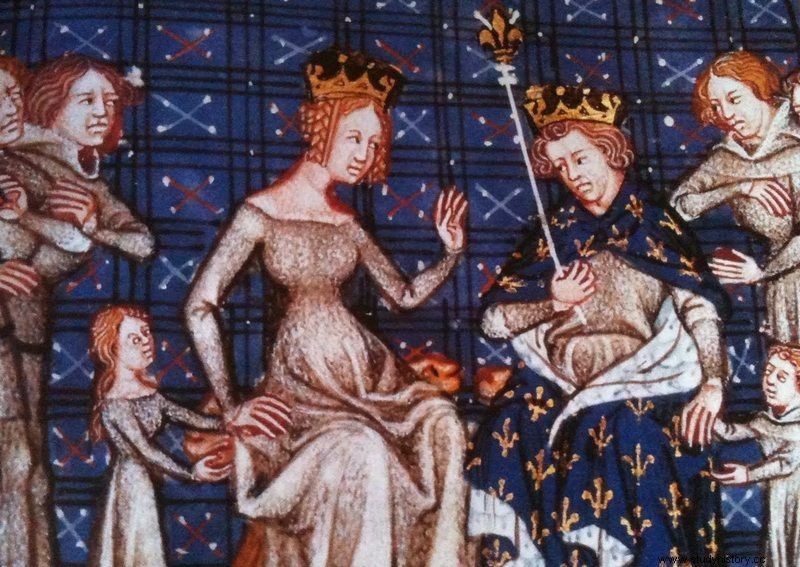
Philip I looked at his first wife with a critical eye. Was she already overweight in his eyes? (source:public domain)
The monarch gave up only after a dozen or so years and he had several children. In 1105 he promised: I will not have any relations or meetings with this woman, except in the presence of honorable persons . He did not keep his word, but because he did not show off with Bertrada, no further curses fell on him.
Relationship invalidation
Church incest laws were not always followed. Even in the Middle Ages, not everyone remembered the names of their great-great-great-great-grandparents, so there were connections between distant cousins. It was even known about kinship, but it was better to keep quiet and keep an ace up your sleeve in case the marriage does not go well.
Louis VII, grandson of King Philip I, married Eleonora, a princess of Aquitaine. Their relationship turned out to be unsuccessful. Finding a common ancestor turned out to be a salvation - they both came from the bigamist Robert the Pious. In 1152, after 15 years together, they were annulled. Louis VII had two more wives and it was only with the last one that he had the longed-for son Philip II Augustus.
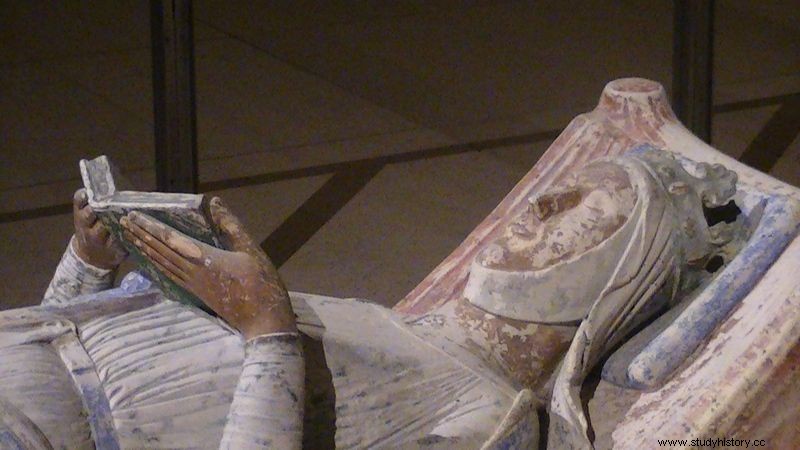
Tombstone of Eleonora Aquitaine at Fontevrault Abbey. She outlived both of her husbands, and was even more closely related to the other than to Louis VII (photo:Adam Bishop, license CC BY-SA 3.0).
Philip himself, following the example of his father, also tried the "annulment into relationship" method. On August 13, 1193, he met his fiancée, the Danish princess Ingebaga, a beautiful eighteen-year-old. The wedding took place on August 14, and on August 15, the newly-minted wife was crowned Queen of France.
To the surprise of those gathered during the ceremony Philip spoke and addressed the Danes accompanying the Queen: Take her back . Ingeborg burst into tears. A dispute that had lasted for years began. Philip's attentive advisers have shown that marriage is incest. In response, the Danes accused them of cheating and showed them a different version of the abandoned woman's genealogy.
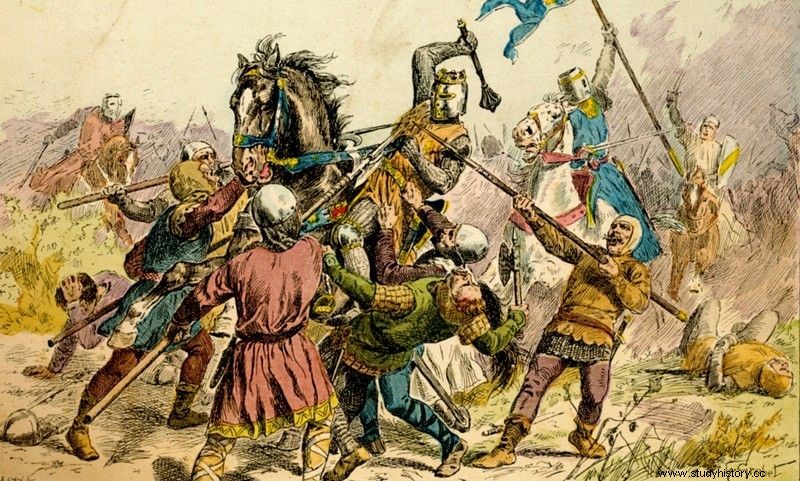
King Philip II Augustus was successful on many battlefields, but in a marital skirmish it was Ingeborg who survived him (work by P.delacroix, license CC BY-SA 4.0).
It was also argued whether the relationship had been consumed. Philip claimed not; Ingeborg I would. In the meantime, the French ruler, like his ancestors, has yet to commit bigamy. The life of a Danish princess imprisoned all these years by her husband was poor . She regained her freedom only after his death in 1223.
Kill the queen!
After Philip Augustus, the French kings calmed down. No bigamy, no excesses, even one saint happened. It was not until 1314 that a scandal broke out that shook France. King Philip IV the Beautiful had three sons, and these had three wives, two of whom had lovers. The third knew about it, but didn't say it, which also made her in trouble.
The case came to light in the spring of 1314. After a public shaving of their heads, the unfaithful women ended up in the fortress of Châtteau-Gallard, and their lovers were flayed, castrated and beheaded. Betrayal could not be the basis for annulment of the marriage, while in each of them there came a moment when her cuckold husband became king of France and wanted to get rid of his unfaithful wife.
The first of them, Małgorzata of Burgundzka, became queen in November 1314, when her husband, Louis X Quarrel, ascended the throne. The new ruler wanted to sire an heir to the throne, but not with Margaret. Already in December, French envoys appeared in Naples for the hand of one of the local queens.

The article was inspired by the series of novels by Maurice Druon entitled "The Cursed Kings" (Otwarte Publishing House 2016).
Ludwik was thinking of getting the marriage annulled, but the pope was not there. For many months the cardinals were unable to gather in a conclave to elect a successor to Saint Peter. The King of France did not have that much time. In April 1315, Margaret was simply strangled to death.
My wife is my sister
The second imprisoned queens, Blanka, was not in danger of any crown for a long time. Her husband, Karol the Beautiful, was the third and youngest brother. Nevertheless, a long series of deaths made him king of France in 1322. Fortunately, there was a pope at that time, and he was John XXII. There was no need to murder the queen, therefore, or the marriage could be annulled.
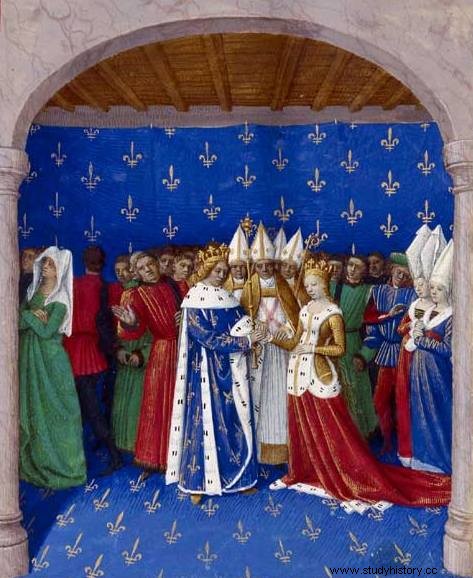
Four months after the annulment of his wife-sister, Charles IV married Mary of Luxembourg (source:public domain).
This time, ordinary kinship was eliminated as a reason, because Blanka and Charles had a dispensation for it, but a spiritual kinship was found. Blanka's mother kept Charles IV until baptism. Simple logic: if the king was his mother-in-law's godson, then he is his wife's godfather. Incest like nothing!
On May 19, 1322, the pope annulled the marriage, allowing both spouses to remarry. Charles eagerly took advantage of this opportunity and married a second time four months later. Meanwhile his the ex-wife was still rotting in prison . In 1325 she was transferred from Châtteau-Gallard to Gavray Castle, where she died a year later.
***
The rulers of other European countries, including Poland, behaved in a similar way, although on a smaller scale. It wasn't until the end of the Middle Ages that getting rid of queens became more difficult. If the marital problems of Henry VIII Tudor had fallen to an earlier era, they would have been just a genealogical curiosity.
